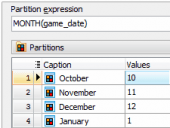Subscribe to our news:

 Partners
 Testimonials
Dave Lantz: "I have to say that I simple love this product and its ease of use. I know that I have only tapped into about 20% of what it can do. In my business I come into a lot of contact with developers and I tell them all, that if they need an easy way to connect, report or work their databases they MUST check out your products".
Javlon: "Beautifully done. This is a stunning software,it creates the pages in no time. Thank you for your hard efforts in creating this software".
More
Add your opinion
 Customers
|
PHP Generator for MySQL online Help
Charts
PHP Generator for MySQL allows you to visualize data on your website with feature-rich, responsive, customizable, and interactive charts.
You can find a number of examples in the Charts group of the Feature Demo. Some more examples can be found at the Games, Players, and Teams page of the NBA Demo.
| 2. | Column, Bar, Pie, Line, Area, Geo, Candlestick, Histogram, Bubble, Stepped Area, Timeline, Gantt, Tree Map and Scatter charts are currently supported. |
| 3. | Charts can be placed in rows above the data grid or below the grid. |
| 4. | Each row can contain any number of charts. |
| 6. | All other properties provided by the library can be customized with the OnPrepareChart event. |
| 7. | Charts are sensitive to the data grid i.e. if you apply a filter to the grid, charts will change accordingly. |
To add a new chart to a webpage or edit an existing one:
| • | Click Add... or Edit... to create a new chart or modify an existing chart accordingly; |
You can hide/show a chart with the Visible checkbox.
|
 Company news 
Aug 23, 2022
New version introduces toggles, one- and two-dimensional barcodes, enhanced lookups sort order, changing page data sources, PHP 8.1 support, editor hints, and other useful things.
Feb 12, 2021
A new version comes with PHP 8.0 support, inline View forms, updated CheckBox Group editor, on-the-fly adding of new items to multi choice controls and other useful improvements.
Sep 10, 2020
A new minor version features the possibility to customize headers and footers of 'Registration', 'Resend verification' and 'Password recovery' pages, revised OnAddEnvironmentVariables event, default values is Cascading Combobox editors and more.
 Resources
The article shows how to implement an AJAX-based one-click editor for a logical column.
This article begins a series of step-by-step tutorials on how we made the NBA demo. It explains how to add new items to the menu, implement run-time theme selection, and tweak the login form.
The article illustrates how to use various chart libraries with PHP Generator.
 Feature of the day
PHP Generator allows you to create a custom pagination i.e. split the records on the generated page by a specified criteria.
PHP Generator allows you to protect the result script with a lot of security settings.
|





 Download
Download Buy
Buy